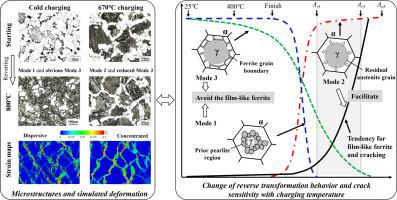当前位置:
X-MOL 学术
›
Mater. Des.
›
论文详情
Our official English website, www.x-mol.net, welcomes your feedback! (Note: you will need to create a separate account there.)
Effect of slab charging temperature on reverse transformation behavior and induced crack sensitivity through experiments and micromechanical analysis
Materials & Design ( IF 8.4 ) Pub Date : 2020-09-01 , DOI: 10.1016/j.matdes.2020.108920 Huasong Liu , Peng Lan , Yannan Dong , Shaoxiang Li , Haiyan Tang , Jiaquan Zhang
Materials & Design ( IF 8.4 ) Pub Date : 2020-09-01 , DOI: 10.1016/j.matdes.2020.108920 Huasong Liu , Peng Lan , Yannan Dong , Shaoxiang Li , Haiyan Tang , Jiaquan Zhang

|
Abstract The relationship between the popular hot charging associated surface crack sensitivity and the charging temperature was studied from the view of phase transformation. The austenite reversion with various charging temperatures was investigated through the thermal simulation experiments. And a two-dimensional representative volume element model was constructed to analyze the crack sensitivity related to microstructures. Compared to cold charging reversion, with the residual austenite in starting microstructure, the kinetics of hot charging reversion is slightly accelerated and the reversion behavior is changed. As the charging temperature increases, the austenite nucleation-growth from pearlite and ferrite grain boundaries are suppressed, while the austenitization through the growth of residual austenite is enhanced. The change of transformation behavior facilitates the formation of ferrite film during reversion through the morphological influence of austenitization modes. With the increasing of charging temperature, the film-like morphology of the evolved ferrite intensifies, especially in the two-phase temperature range. Consequently, the calculated crack sensitivity index rises sharply from 0.0006 to 0.029 when the charging temperature increases from Ar1 to Ar3 temperature, which is agreeable with the statistical production data. Additionally, it was observed that the incomplete γ → α → γ transformation cannot bring an effective austenite grain refining for the present steel.
中文翻译:

通过实验和微观力学分析板坯装料温度对逆相变行为和诱发裂纹敏感性的影响
摘要 从相变的角度研究了流行的热装相关表面裂纹敏感性与装料温度之间的关系。通过热模拟实验研究了不同装料温度下的奥氏体回复。并构建二维代表性体积元模型来分析与微观结构相关的裂纹敏感性。与冷装回炉相比,在初始组织中残留奥氏体的情况下,热装回炉的动力学略有加速,回炉行为发生了变化。随着装料温度的升高,珠光体和铁素体晶界的奥氏体形核生长受到抑制,同时通过残余奥氏体的生长促进奥氏体化。转变行为的变化通过奥氏体化模式的形态影响促进了回复过程中铁素体膜的形成。随着充电温度的升高,析出的铁素体的膜状形态加剧,特别是在两相温度范围内。因此,当充料温度从Ar1 升高到Ar3 温度时,计算的裂纹敏感性指数从0.0006 急剧上升到0.029,这与统计生产数据一致。此外,观察到不完全的γ→α→γ转变不能为本钢带来有效的奥氏体晶粒细化。演化出的铁素体的薄膜状形态增强,尤其是在两相温度范围内。因此,当充料温度从Ar1 升高到Ar3 温度时,计算的裂纹敏感性指数从0.0006 急剧上升到0.029,这与统计生产数据一致。此外,观察到不完全的γ→α→γ转变不能为本钢带来有效的奥氏体晶粒细化。演化出的铁素体的薄膜状形态增强,尤其是在两相温度范围内。因此,当充料温度从Ar1 升高到Ar3 温度时,计算的裂纹敏感性指数从0.0006 急剧上升到0.029,这与统计生产数据一致。此外,观察到不完全的γ→α→γ转变不能为本钢带来有效的奥氏体晶粒细化。
更新日期:2020-09-01
中文翻译:

通过实验和微观力学分析板坯装料温度对逆相变行为和诱发裂纹敏感性的影响
摘要 从相变的角度研究了流行的热装相关表面裂纹敏感性与装料温度之间的关系。通过热模拟实验研究了不同装料温度下的奥氏体回复。并构建二维代表性体积元模型来分析与微观结构相关的裂纹敏感性。与冷装回炉相比,在初始组织中残留奥氏体的情况下,热装回炉的动力学略有加速,回炉行为发生了变化。随着装料温度的升高,珠光体和铁素体晶界的奥氏体形核生长受到抑制,同时通过残余奥氏体的生长促进奥氏体化。转变行为的变化通过奥氏体化模式的形态影响促进了回复过程中铁素体膜的形成。随着充电温度的升高,析出的铁素体的膜状形态加剧,特别是在两相温度范围内。因此,当充料温度从Ar1 升高到Ar3 温度时,计算的裂纹敏感性指数从0.0006 急剧上升到0.029,这与统计生产数据一致。此外,观察到不完全的γ→α→γ转变不能为本钢带来有效的奥氏体晶粒细化。演化出的铁素体的薄膜状形态增强,尤其是在两相温度范围内。因此,当充料温度从Ar1 升高到Ar3 温度时,计算的裂纹敏感性指数从0.0006 急剧上升到0.029,这与统计生产数据一致。此外,观察到不完全的γ→α→γ转变不能为本钢带来有效的奥氏体晶粒细化。演化出的铁素体的薄膜状形态增强,尤其是在两相温度范围内。因此,当充料温度从Ar1 升高到Ar3 温度时,计算的裂纹敏感性指数从0.0006 急剧上升到0.029,这与统计生产数据一致。此外,观察到不完全的γ→α→γ转变不能为本钢带来有效的奥氏体晶粒细化。



























 京公网安备 11010802027423号
京公网安备 11010802027423号